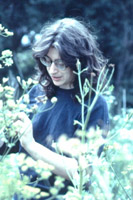 |
May Berenbaum In the past 3 years, as in the past 24, my research remains
resolutely alliterative—primarily projects on parsnips, papilionids, and P450s. In
terms of the parsnip work, after 17 years in Champaign County, Art Zangerl (my superhuman
long-time collaborator and friend) and I branched out to other exotic locales (Peotone and
Charleston, IL, among them) to investigate geographic aspects of the interaction between
wild parsnips and the parsnip webworm. To our astonishment, we found a remarkable degree
of matching of chemical phenotype; the furanocoumarin defense profile of the plant
populations coincided amazingly well with the detoxicative capacity of the associated
insect populations. Such phenotype matching is for many reasons tough to attribute to
anything other than reciprocal selective responses. This work was (alliteratively)
published in the Proceedings of the National Academy of Sciences (had we been
working on navel orangeworms I suppose we would have sent the manuscript to Nature).
Work also progresses on the impact of variation in plant primary metabolites on the
toxicity of furanocoumarins; carotenoids affect P450-mediated detoxification in the
webworm, as does phytic acid.
On the papilionid front, Dr. Susanne Timmermann, a visiting
postdoctoral associate from Germany, examined the function of nonenzymatic antioxidants in
species, such as Papilio polyxenes, the black swallowtail, that specialize on
phototoxic plants. Among the compounds she examined in P. polyxenes was uric acid,
generally thought of as a waste product but long suspected to act internally as an
antioxidant. Susanne documented the uric acid content of various tissue types in the
presence and absence of prooxidants in the diet and in the process discovered that uric
acid is concentrated in third instars in the characteristic shiny white dot marking on the
dorsum of the caterpillar. These caterpillars are universally regarded as mimics of bird
droppings. The resemblance to bird droppings is uncanny at least in part because the shiny
white glob on a real bird dropping is also uric acid. Retaining the waste material in the
case of the swallowtails, then, confers a protective visual as well as biochemical
antioxidant function, proving that anal-retentiveness really can pay off (for the
swallowtails, not Susanne!).
In terms of P450s, the heme-containing detoxification
enzymes of caterpillar midguts, work proceeds apace within Papilio, in
collaboration with department affiliate Mary Schuler. In addition to the two genes from P.
polyxenes, at least one of which encodes an enzyme that metabolizes furanocoumarins,
we now have characterized two genes from P. glaucus, the tiger swallowtail, at
least one of which encodes an enzyme that metabolizes furanocoumarins (oddly enough, in a
species that only rarely ever encounters furanocoumarins in its many hostplants). With
research associate Xianchun Li, we’ve branched out beyond the Papilionidae, to see
how broadly polyphagous lepidopterans handle furanocoumarins; we now have a full-length
cDNA from Helicoverpa zea, the corn earworm, that appears to be a likely candidate.
Working on H. zea, however, brings the lab perilously close to doing work of real
economic importance (parsnip and its enemies never really having made a major contribution
to the agricultural sector in the U.S.).
As for my personal life, I’m happy to report that
husband Richard recently completed several consecutive terms as president of the Society
for Animation Studies. This position hasn’t inflated his ego unduly; he likes to
point out that the SAS has fewer members than the Sparkplug Collectors of America.
Eight-year-old daughter Hannah continues to delight and amaze. Like her mother, she has
interests that are alliterative; at the moment, they include collecting Barbies, Beanie
Babies, and books. "Bugs" don’t even make the list, alliteration
notwithstanding. As for musical tastes, to Mommy’s chagrin, they’ve shifted from
"Weird Al" Yankovic to the Spice Girls (better, alphabetically at least, she should
be into the Backstreet Boys or Barenaked Ladies!). |
